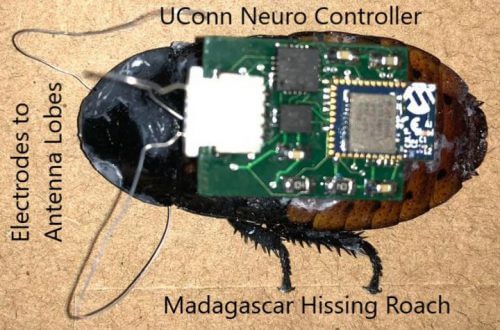A tiny neural controller developed by researchers at the University of Connecticut (UConn) could provide more precise operation of micro-robots, such as those being tested in "cyborg" installations for possible use in search and rescue missions inside collapsed buildings

A tiny neural controller developed by researchers at the University of Connecticut (UConn) could provide more precise operation of micro-robots, such as those being tested in "cyborg" devices for possible use in search and rescue missions inside collapsed buildings.
For much of the past decade, scientists have been researching ways to tether live insects to miniaturized computer hardware so they can actuate the insect's movements. Such options are of interest to the US Department of Defense, search and rescue teams, and others.
Success has been limited and various technological difficulties continue to exist. This is mainly due to the enormous difficulty of building robotic systems on such a small scale and the difficulty of creating an interface between electronic equipment and the biological nervous tissue of the insect to initiate movement.
The neural microcontroller circuit developed at UConn is part of a tiny electronic "backpack" that can be attached to an insect with its wires connected to the insect's tentacle lobes. By sending small electrical charges to nerve tissue in the insect's left or right tentacle lobe, the actuators can trick the insect into thinking it has detected an obstacle, causing it to move in a different direction. A charge sent to the right tentacle causes the cockroach to move to the left. Similarly, a charge sent to the left tentacle causes it to move to the right.
Similar insect control systems already exist, but what makes UConn's controller unique is the degree to which operators can stimulate the insect's tentacle lobes using a four-channel microcircuit. The system also provides real-time feedback on the insect's nerve and muscle response to stimuli. Thanks to this level of detail it is easy to monitor and control the movement, an advantage that has been trying to find for a long time in the community of tiny robotic insects.
Insects as a robotic platform
"Using insects as platforms for small robots has an incredible number of useful applications from search and rescue to national security," says Abhishek Dutta, a senior lecturer in electrical and computer engineering at UConn, who developed the circuit with postdoctoral researcher in his lab, Ivan Faulkner. "We believe that our microcircuit provides a more sophisticated and reliable control system that advances us another step to the application of this technology in the real world."
To test the new controller, Dota, an expert in control system optimization and cyber-physical systems, connected the device to a whispering patch in his lab. The experiments showed that the cockroach moved to the left when its right tentacle lobe was torn and moved to the right when the left one received a small electrical charge.
The researchers noticed an interesting thing: the intensity of the cockroach's movement to the left or right in response to an artificial stimulus decreases after the initial stimulus. So if the cockroach made a large left turn after the first electrical pulse hit its right tentacle lobe, its left turn was less dramatic with each subsequent pulse to that lobe.
Dutta and Faulkner intend to conduct further research to perfect the system.
More of the topic in Hayadan:

One response
The research is interesting, more interesting to what extent it can be useful in disaster situations - if it will be useful at all. Now the question is what is the lifespan of the cyborg cockroach and how long does it take to wire (for example) ten new cockroaches.